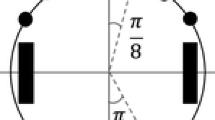Abstract
How does communication originates in a population of originally non-communicating individuals? Providing an answer to this question from a neo-Darwinian epistemological perspective is not a trivial task. The reason is that, for non-communicating agents, the capabilities of emitting signals and responding to them are both adaptively neutral traits if they are not simultaneously present. Research studies based on rather general and theoretically oriented evolutionary simulation models have, so far, demonstrated that at least two different processes can account for the origin of communication. On the one hand, communicative behaviour may first evolve in a non-communicative context and only subsequently acquire its adaptive function. On the other hand, communication may originate thanks to cognitive constraints; that is, communication may originate thanks to the existence of neural substrates that are common to the signalling and categorising capabilities. This article provides a proof-of-concept demonstration of the origin of communication in a novel-simulated scenario in which groups of two homogeneous (i.e. genetically identical) agents exploit reciprocal communication to develop common perceptual categories and to perform a collective task. In particular, in circumstances in which communication is evolutionarily advantageous, simulated agents evolve from scratch social behaviour through acoustic interactions. We look into the phylogeny of successful communication protocol, and we describe the evolutionary phenomena that, in early evolutionary stages, paved the way for the subsequent development of reciprocal communication, categorisation capabilities and successful cooperative strategies.
Similar content being viewed by others
References
Ampatzis C, Tuci E, Trianni V, Dorigo M (2008) Evolution of signaling in a multi-robot system: categorization and communication. Adapt Behav 16(1): 5–26
Balch T, Arkin RC (1994) Communication in reactive multiagent robotic systems. Auton Robot 1(1): 27–52
Baldassarre G, Nolfi S, Parisi D (2003) Evolving mobile robots able to display collective behaviour. Artif Life 9: 255–267
Beer RD, Gallagher JC (1992) Evolving dynamic neural networks for adaptive behavior. Adapt Behav 1(1): 91–122
Cangelosi A, Parisi D (1998) The emergence of a “language” in an evolving population of neural networks. Connect Sci 10(2): 83–97
Cangelosi A, Parisi D (eds) (2002) Simulating the evolution of language. Springer, London, UK
Cao YU, Fukunaga AS, Kahng A (1997) Cooperative mobile robotics: antecedents and directions. Auton Robot 4(1): 7–27
Dawkins R, Krebs JR (1978) Animal signals: information or manipulation?. In: Krebs J, Davis N (eds) Behavioural ecology: an evolutionary approach. Blackwell, Oxford, pp 282–309
Di Paolo EA (2000) Behavioral coordination, structural congruence and entrainment in a simulation of acoustically coupled agents. Adapt Behav 8(1): 27–48
Floreano D, Mitri S, Magnenat S, Keller L (2007) Evolutionary conditions for the emergence of communication in robots. Curr Biol 17: 514–519
Fong T, Nourbakhsh I, Dautenhahn K (2002) A survey of socially interactive robots. Robot Auton Syst 42(3–4): 143–166
Goldberg DE (1989) Genetic algorithms in search, optimization and machine learning. Addison-Wesley, Reading, MA
Harnad S (eds) (1987) Categorical perception: the groundwork of cognition. Cambridge University Press, New York
Harvey I, Di Paolo EA, Wood R, Quinn M, Tuci E (2004) Evolutionary robotics: a new scientific tool for studying cognition. Artif Life 11(1–2): 79–98
Hauser MD (1996) The evolution of communication. MIT Press, Cambridge, MA
Marocco D, Nolfi S (2007) Emergence of communication in embodied agents evolved for the ability to solve a collective navigation problem. Connect Sci 19(1): 53–74
Marocco D, Cangelosi A, Nolfi S (2003) The emergence of communication in evolutionary robots. Phil Trans R Soc London Ser A 361: 2397–2421
Maynard-Smith J, Harper DG (1995) Animal signals: models and terminology. J Theor Biol 177: 305–311
Maynard-Smith J, Price GR (1973) The logic of animal conflict. Nature 246: 15–18
Mirolli M, Parisi D (2008) How producer biases can favor the evolution of communication: an analysis of evolutionary dynamics. Adapt Behav 16(1): 27–52
Mondada F, Pettinaro GC, Guignard A, Kwee IV, Floreano D, Deneubourg JL, Nolfi S, Gambardella LM, Dorigo M (2004) SWARM-BOT: a new distributed robotic concept. Auton Robot 17(2–3): 193–221
Nolfi S, Floreano D (2000) Evolutionary robotics: the biology, intelligence, and technology of self-organizing machines. MIT Press, Cambridge, MA
Pfeifer R, Scheier C (2001) Understanding intelligence. MIT Press, Cambridge, MA
Quinn M (2001) Evolving communication without dedicated communication channels. In: Kelemen J, Sosik P (eds) Advances in artificial life: 6th European conference on artificial life. Springer, Berlin, Germany, pp 357–366
Quinn M, Smith L, Mayley G, Husbands P (2003) Evolving controllers for a homogeneous system of physical robots: structured cooperation with minimal sensors. Phil Trans R Soc Lond Ser A 361: 2321–2344
Steels L (2003) Evolving grounded communication for robots. Trends Cognit Sci 7(7): 308–312
Støy K (2001) Using situated communication in distributed autonomous mobile robots. In: Proceedings of the 7th Scandinavian conference on artificial intelligence. IOS Press, Amsterdam, The Netherlands, pp 44–52
Trianni V, Dorigo M (2006) Self-organisation and communication in groups of simulated and physical robots. Biol Cybern 95: 213–231
Tuci E, Ampatzis C, Vicentini F, Dorigo M (2008) Evolving homogeneous neuro-controllers for a group of heterogeneous robots: coordinated motion, cooperation, and acoustic communication. Artif Life 14(2): 211–230
Vicentini F, Tuci E (2006) Swarmod: a 2d s-bot’s simulator. Technical Report TR/IRIDIA/2006-005, IRIDIA, CoDE, Université Libre de Bruxelles. Available at http://iridia.ulb.ac.be/IridiaTrSeries.html
Von Frisch K (1967) The dance language and orientation of bees. Harvard University Press, Cambridge, MA
Williams PL, Beer RD, Gasser M (2008) Evolving referential communication in embodied dynamical agents. In: Bullock S, Noble J, Watson R, Bedau M (eds) Proceedings of the 11th international conference on the simulation and synthesis of living systems, ALife XI. MIT Press, Cambridge, MA, pp 702–709
Author information
Authors and Affiliations
Corresponding author
Rights and permissions
About this article
Cite this article
Tuci, E. An investigation of the evolutionary origin of reciprocal communication using simulated autonomous agents. Biol Cybern 101, 183–199 (2009). https://doi.org/10.1007/s00422-009-0329-2
Received:
Accepted:
Published:
Issue Date:
DOI: https://doi.org/10.1007/s00422-009-0329-2




